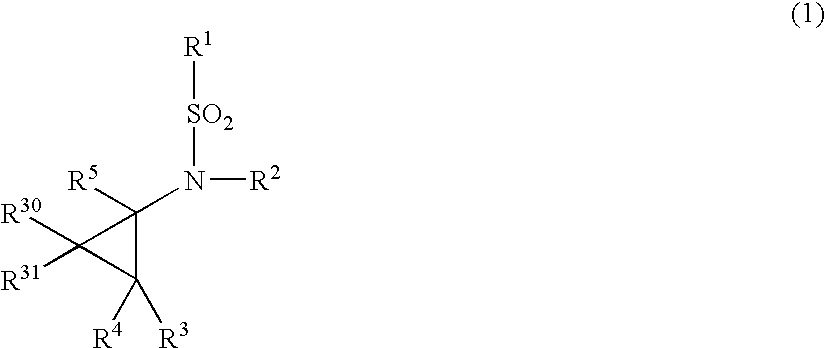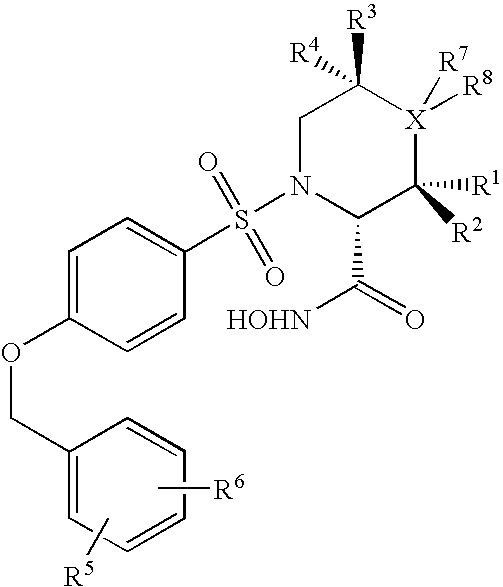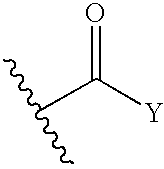N-substituted-n-sulfonylaminocyclopropane compounds and pharmaceutical use thereof
- Summary
- Abstract
- Description
- Claims
- Application Information
AI Technical Summary
Benefits of technology
Problems solved by technology
Method used
Image
Examples
production example 1-1
2-(3-benzyloxyphenyl)-cyclopropane-1,1-dicarboxylic acid dimethyl ester (step 1-1)
[0765]
[0766] This procedure was performed according to the method described in J. Med. Chem. 1992, 35, 1410-1417.
[0767] While water-bathing, to a suspension of sodium hydride (liquid paraffin 40% added, 5.0 g, 0.13 mol) in dimethyl sulfoxide (180 mL) was gradually added trimethylsulfoxonium iodide (28 g, 0.13 mmol) under argon atmosphere, and the mixture was stirred for 30 min. Then dimethyl 2-(3-benzyloxybenzylidene)malonate (37 g, 0.11 mol) synthesized by the method described in the above-mentioned reference was added dropwise. After stirring for 1 hr at 50° C., saturated aqueous ammonium chloride solution (200 mL) and toluene (100 mL) were added to the obtained solution. The mixture was separated into layers and extracted with toluene (100 mL). The organic layer was sequentially washed with water (100 mL) and saturated aqueous sodium chloride solution (20 mL) and dried over magnesium sulfate. Afte...
production example 1-2
(1R*,2R*, 3R*)-2-methyl-3-phenylcyclopropane-1,1-dicarboxylic acid monomethyl ester (step 1-2)
[0768]
[0769] To a solution of (2R*,3R*)-2-methyl-3-phenyl-cyclopropane-1,1-dicarboxylic acid dimethyl ester (39 g, 0.16 mol) obtained in Preparation Example 1-7-2 in methanol (390 mL) was added 4N aqueous sodium hydroxide solution (160 mL, 0.62 mol) at 0° C., and the mixture was stirred for 18 hrs at room temperature. After the mixture was concentrated under reduced pressure, diethyl ether and water were added and the mixture was stirred. After the organic layer was removed, concentrated hydrochloric acid was added to the aqueous layer at 0° C. until the pH level read about 1. The organic layer was extracted with ethyl acetate, washed with saturated aqueous sodium chloride solution, and dried over sodium sulfate. The solution was filtrated and the solvent was evaporated. The obtained crude product was azeotroped with toluene, and diethyl ether and hexane were added gradually. The precipita...
production example 1-3
(1R*,2S*,3S*)-1-t-butoxycarbonylamino-2-methyl-3-phenyl-cyclopropanecarboxylic acid methyl ester (step 1-3)
[0770]
[0771] To a solution of 2-methyl-3-phenylcyclopropane-1,1-dicarboxylic acid mono-methyl ester (36 g, 0.16 mol) obtained in Preparation Example 1-11 and triethylamine (35 mL, 0.25 mol) in t-butylalcohol (370 mL) was added diphenylphosphoryl azide (44 mL, 0.20 mol). After stirring for 2 hrs at room temperature, the mixture was warmed gradually and refluxed for 7 hrs. After the solvent was evaporated under reduced pressure, a mixed solvent of hexane:ethyl acetate=4:1 (750 mL) and silica gel (200 g) were added and the mixture was stirred for 30 min. Then silica gel was removed, and the mixture was concentrated under reduced pressure. Hexane was added to the obtained residue, and the precipitated crystals were filtrated to give the title compound (35 g, yield 74%) as a white solid.
PUM
| Property | Measurement | Unit |
|---|---|---|
| Electrical conductance | aaaaa | aaaaa |
| Therapeutic | aaaaa | aaaaa |
| Inhibition | aaaaa | aaaaa |
Abstract
Description
Claims
Application Information
 Login to View More
Login to View More - R&D
- Intellectual Property
- Life Sciences
- Materials
- Tech Scout
- Unparalleled Data Quality
- Higher Quality Content
- 60% Fewer Hallucinations
Browse by: Latest US Patents, China's latest patents, Technical Efficacy Thesaurus, Application Domain, Technology Topic, Popular Technical Reports.
© 2025 PatSnap. All rights reserved.Legal|Privacy policy|Modern Slavery Act Transparency Statement|Sitemap|About US| Contact US: help@patsnap.com



